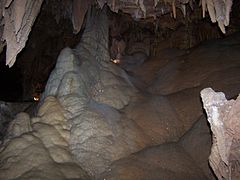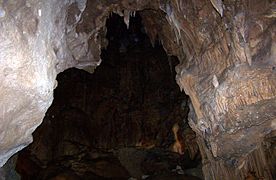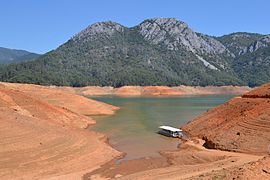
A stalagmite is a type of rock formation that rises from the floor of a cave due to the accumulation of material deposited on the floor from ceiling drippings. Stalagmites are typically composed of calcium carbonate, but may consist of lava, mud, peat, pitch, sand, sinter, and amberat.

The Natural Bridge Caverns are the largest known commercial caverns in the U.S. state of Texas. The name is derived from the 60 ft natural limestone slab bridge that spans the amphitheater setting of the cavern's entrance. The span was left suspended when a sinkhole collapsed below it.

A speleothem is a geological formation by mineral deposits that accumulate over time in natural caves. Speleothems most commonly form in calcareous caves due to carbonate dissolution reactions. They can take a variety of forms, depending on their depositional history and environment. Their chemical composition, gradual growth, and preservation in caves make them useful paleoclimatic proxies.

Luray Caverns, originally called Luray Cave, is a cave just west of Luray, Virginia, United States, which has drawn many visitors since its discovery in 1878. The cavern system is generously adorned with speleothems such as columns, mud flows, stalactites, stalagmites, flowstone, and mirrored pools. The caverns are perhaps best known for the Great Stalacpipe Organ, a lithophone made from solenoid-fired strikers that tap stalactites of various sizes to produce tones similar to those of xylophones, tuning forks, or bells.
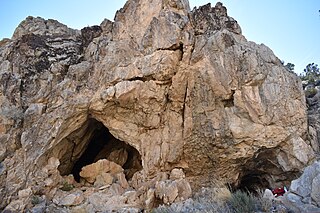
The Mitchell Caverns, within the Mitchell Caverns Natural Preserve, are three solution limestone caves, only two of which are open to the public, located on the east side of the Providence Mountains at an elevation of 4,300 feet (1,300 m), within the Providence Mountains State Recreation Area. The caverns are located in the Mojave Desert, in San Bernardino County, California.

Florida Caverns State Park is a state park of Florida in the United States, part of the Florida State Parks system. It is located in the Florida Panhandle near Marianna. It is the only Florida state park with air-filled caves accessible to the public.
Cosmic Cavern is a limestone cave located in north Arkansas, near the town of Berryville, Arkansas. One brochure for the cave touts it as "Arkansas' Most Beautifully Decorated Cave." It is the "warmest" cave in the Ozarks, having a high humidity holding at a constant 64 °F year-round. Most caves in the area are between 55° and 60°.

Treak Cliff Cavern is a show cave near Castleton in Derbyshire, England. It is part of the Castleton Site of Special Scientific Interest and one of only two sites where the ornamental mineral Blue John is still excavated. As part of an agreement with English Nature, the Blue John that can be seen in the show cave is not mined but it is extracted in small quantities from other areas of the cave and made into saleable items like bowls, jewellery, and ornaments.

Cave of the Winds is a cave in the Pikes Peak region of Colorado. It is located just west of Colorado Springs on U.S. Highway 24, near the Manitou Cliff Dwellings. Tours of the complex of caves are given daily.
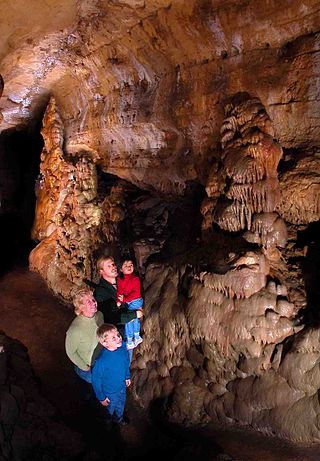
Cave of the Mounds, a natural limestone cave located near Blue Mounds, Wisconsin, United States, is named for two nearby hills called the Blue Mounds. It is located in the southern slope of the east hill. The cave's beauty comes from its many varieties of mineral formations called speleothems. The Chicago Academy of Sciences considers the Cave of the Mounds to be "the significant cave of the upper Midwest" because of its beauty, and it is promoted as the "jewel box" of major American caves. In 1987, the United States Department of the Interior and the National Park Service designated the cave as a National Natural Landmark.

Illinois Caverns is a state natural area in the New Design Precinct of Monroe County, Illinois. It features Illinois Caverns which is alternatively known as Mammoth Cave of Illinois. Illinois Caverns is the second-largest cave in Illinois and has more than 9.6 km of passages. The cave has a constant temperature of 58 °F (14 °C), and portions flood during wet weather. Passages can be 20 feet (6.1 m) high and just as wide. It is located off Illinois Route 3, south of Waterloo, near the unincorporated community of Burksville.
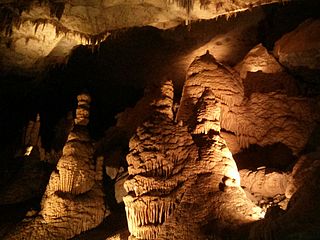
Cumberland Caverns is a national natural landmark and show cave located in McMinnville, Tennessee. It is the second longest cave in Tennessee and makes the list of longest caves in the United States and in the world.
[[File:Black Chasm Landmark Room.jpg|thumb|300 RC), and currently Gold Country Adventures. Black Chasm was selected for consideration as a National Natural Landmark (NNL) in 1975 after National Park Service personnel entered into the cave and saw the helictite crystal display in the Landmark Room. The park service personnel described Black Chasm as having, "The best helictites in the west.". At the time, Black Chasm was slated to be quarried, as an open pit mine, for the gravel that the bedrock would provide. The quarry company who owned the land was aware of the cave, but not of its rare display of helictites. After the NNL status was granted in January 1976, the quarry company still had legal rights to quarry the property, but there was a moral obligation placed on the landowners to preserve the cave in order to retain its NNL status.<ref name="nps2">{{cite web|url=http://www.nature.nps.gov/nnl/faq.cfm#

The Wyandotte Caves is a pair of limestone caves located on the Ohio River in Harrison-Crawford State Forest in Crawford County, 5 miles (8 km) north-east of Leavenworth and 12 miles (19 km) from Corydon in southern Indiana which are a popular tourist attraction. Wyandotte Caves were designated a National Natural Landmark in 1972. They are now part of O'Bannon Woods State Park. The cave system is the 5th largest in the state of Indiana.
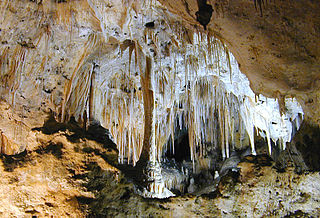
Carlsbad Caverns National Park is an American national park in the Guadalupe Mountains of southeastern New Mexico. The primary attraction of the park is the show cave Carlsbad Cavern. Visitors to the cave can hike in on their own via the natural entrance or take an elevator from the visitor center.

Rimstone, also called gours, is a type of speleothem in the form of a stone dam. Rimstone is made up of calcite and other minerals that build up in cave pools. The formation created, which looks like stairs, often extends into flowstone above or below the original rimstone. Often, rimstone is covered with small, micro-gours on horizontal surfaces. Rimstone basins may form terraces that extend over hundreds of feet, with single basins known up to 200 feet long from Tham Xe Biang Fai in Laos.

Grand Caverns, formerly known as Weyer's Cave, is located in the central Shenandoah Valley in the town of Grottoes, Virginia, United States. A limestone cavern, it claims the distinction of being America's oldest show cave, in operation since 1806.
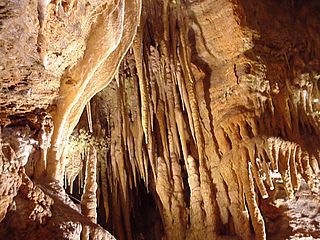
Crystal Grottoes is the only show cave in the U.S. state of Maryland. It is located on Maryland Route 34 between Boonsboro and Antietam National Battlefield.

Lost World Caverns, located just outside Lewisburg, West Virginia, is an underground natural series of caverns. In November 1973, the caverns were registered as a National Natural Landmark as they "feature terraced pedestal-like stalagmites, flowstone, curtains, rimstone, domepits, and waterfalls."
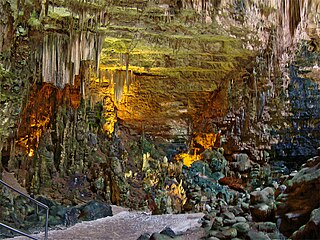
The Castellana Caves are a karst cave system located in the municipality of Castellana Grotte, in the Metropolitan City of Bari, Apulia, southern Italy.



